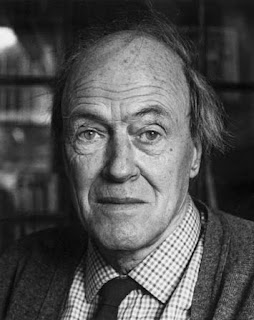 |
| Roald Dahl, 1916-1990 |
I was in a bookshop when an enthusiastic young boy - aged six or seven - wandered in with a grandparent and asked where he could find the Roald Dahl books.
I think Fantastic Mr Fox was the first Dahl book I read - it had the pre-Quentin Blake illustrations, so it must have been 1975 or 1976.
I then devoured Charlie and the Chocolate Factory before working my way through the rest that had been published at that time.
In my teens I discovered his grown-up stories, the wonderfully macabre Tales of the Unexpected, and promptly became addicted.
I still have my well-thumbed hardback collection of them on my bookshelf.
The TV adaptations shown on ITV on Sunday nights in the late 1970s were a guilty pleasure (when I could convince my parents to let me stay up and watch them).
In 1989 I had a short spell training to be a teacher before realising I wasn't cut out for the job, switched courses and launched myself into the world of journalism instead.
But during the few weeks I actually did teaching practice (in a multi-cultural primary school in Blackburn) I read the children The Witches, which had just been published. It was a delight to see Dahl's storytelling working its magic on the youngsters.
In 1990 I considered writing a fan letter to Dahl. So I acquired his address - Gipsy House in Great Missenden - from the college library.
But for some reason I put off actually committing pen to paper. It's something I've regretted ever since, for he died that November.
In 1999 I made a Roald Dahl pilgrimage to Great Missenden with my wife, herself weened on his books.
 |
| Dahl's writing shed at Gipsy House |
In the lane at the side of the house we were greeted by an old-looking Jack Russell terrier that sniffed inquisitively at our feet before being called to heel by its owner, a dark-haired lady in her fifties.
 |
| Dahl with two pets - Chopper the Jack Russell is on the left |
We then paid our respects by visiting Dahl's grave in the churchyard of Saint Peter and Paul Church on the hillside opposite the village, reached via a footbridge across a busy dual carriageway.
In those days the grave was marked by a simple, small memorial plaque. Chocolate bars had been placed on the grave by fans in tribute to their chocoholic hero.
My wife and I have often talked about that visit over the years. So in October 2008 during a trip to the London area to celebrate my fortieth birthday we took our two young children to Great Missenden.
 |
| Roald Dahl also wrote macabre short stories for adults |
 |
| The Roald Dahl Museum and Story Centre, in Great Missenden |
It can be found on the high street in the village, close to various buildings and landmarks associated with the great author's stories, including the old-style petrol pumps from Danny the Champion of the World, and the building that was Sophie's 'norphanage' in The BFG.
Besides being a state-of-the-art repository for his letters and manuscripts, the museum is a brilliant tribute to the great man entirely in keeping with his spirit.
His life story is told in a variety of rooms with fascinating displays. I particularly loved one of Dahl's monstrous sandals which he sent to illustrator Quentin Blake as a model for the BFG's footwear.
Chief among the exhibits is in the main part of the museum - an exact recreation of Dahl's writing shed, complete with armchair, green baize-covered writing board and 'memento-table' with the head of his femur acquired during a hip replacement operation and a foil ball from all the bars of chocolate Dahl ate over the years.
 |
| Dahl at work in his writing shed |
Children cannot fail to be seduced by the activities on offer - they're given the opportunity to create their own BFG-style nonsense words and are given tips on how to write their own stories.
There are also storytelling workshops, where the children are treated to performances of Dahl's rhymes by museum staff.
The day we visited, Great Missenden was covered in snow. After the museum, we trudged up the lane to Gipsy House, which looked gorgeous blanketed in white.
In the nine years since our previous visit, fences had been erected around the property, which meant we couldn't see the writing shed.
There was no sign of Mrs Dahl on this occasion while Chopper no doubt had long gone to meet his master in heaven.
But we paused under the railway bridge on the country lane where Dahl used to take his children at night to listen to the last train to London thundering overhead while telling them ghost stories.
 |
| Roald Dahl's grave |
And perhaps the sweetest thing of all were the concrete BFG footprints leading to Dahl's grave from a commemorative bench nearby, bearing a lovely quote from The Giraffe and the Pelly and Me.
 |
| The BFG's footprints |






